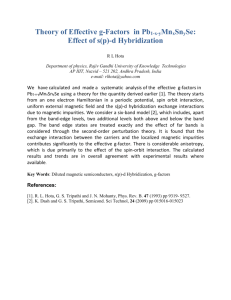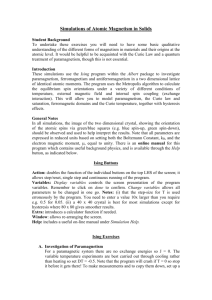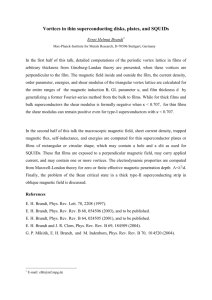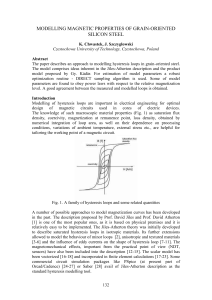EPAPS_online_material
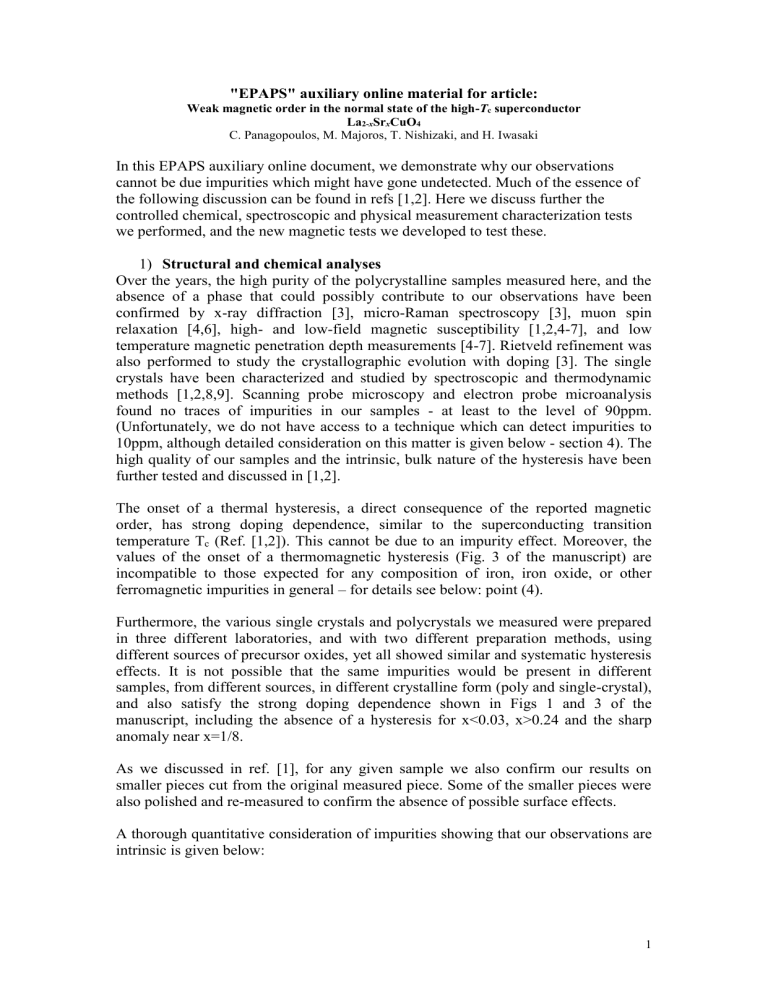
"EPAPS" auxiliary online material for article:
Weak magnetic order in the normal state of the high-T c
superconductor
La
2-x
Sr x
CuO
4
C. Panagopoulos, M. Majoros, T. Nishizaki, and H. Iwasaki
In this EPAPS auxiliary online document, we demonstrate why our observations cannot be due impurities which might have gone undetected. Much of the essence of the following discussion can be found in refs [1,2]. Here we discuss further the controlled chemical, spectroscopic and physical measurement characterization tests we performed, and the new magnetic tests we developed to test these.
1) Structural and chemical analyses
Over the years, the high purity of the polycrystalline samples measured here, and the absence of a phase that could possibly contribute to our observations have been confirmed by x-ray diffraction [3], micro-Raman spectroscopy [3], muon spin relaxation [4,6], high- and low-field magnetic susceptibility [1,2,4-7], and low temperature magnetic penetration depth measurements [4-7]. Rietveld refinement was also performed to study the crystallographic evolution with doping [3]. The single crystals have been characterized and studied by spectroscopic and thermodynamic methods [1,2,8,9]. Scanning probe microscopy and electron probe microanalysis found no traces of impurities in our samples - at least to the level of 90ppm.
(Unfortunately, we do not have access to a technique which can detect impurities to
10ppm, although detailed consideration on this matter is given below - section 4). The high quality of our samples and the intrinsic, bulk nature of the hysteresis have been further tested and discussed in [1,2].
The onset of a thermal hysteresis, a direct consequence of the reported magnetic order, has strong doping dependence, similar to the superconducting transition temperature T c
(Ref. [1,2]). This cannot be due to an impurity effect. Moreover, the values of the onset of a thermomagnetic hysteresis (Fig. 3 of the manuscript) are incompatible to those expected for any composition of iron, iron oxide, or other ferromagnetic impurities in general – for details see below: point (4).
Furthermore, the various single crystals and polycrystals we measured were prepared in three different laboratories, and with two different preparation methods, using different sources of precursor oxides, yet all showed similar and systematic hysteresis effects. It is not possible that the same impurities would be present in different samples, from different sources, in different crystalline form (poly and single-crystal), and also satisfy the strong doping dependence shown in Figs 1 and 3 of the manuscript, including the absence of a hysteresis for x<0.03, x>0.24 and the sharp anomaly near x=1/8.
As we discussed in ref. [1], for any given sample we also confirm our results on smaller pieces cut from the original measured piece. Some of the smaller pieces were also polished and re-measured to confirm the absence of possible surface effects.
A thorough quantitative consideration of impurities showing that our observations are intrinsic is given below:
1
2) M(T) method
In Ref. [2] we report a new method to distinguish intrinsic from extrinsic effects on a measured thermomagnetic hysteresis. This method was developed as part of our extensive quality tests. As discussed in Ref. [2], separate experiments, like those depicted in Fig. 1 of Ref. [2] for a pure LSCO (x=0.15) single crystal, were performed on pure Fe, and Fe-contaminated samples. Unlike the pure samples, the results showed that the data obtained by cooling the sample in zero magnetic-field did not follow a “straight-zero-line”, i.e., a T-independent magnetization (for details please see Ref. 2), but the magnetic moment increased with decreasing temperature.
Moreover, the ratio of the width of the hysteresis at 100K to the magnetic moment at
300K was at least one order of magnitude lower for the iron and iron-contaminated samples than that obtained for the pure samples [2].
Another evidence against impurities comes from our earlier measurements (on the
Sr=0.15 crystal studied also here) of the magnetization as a function of temperature
[2]. In that work by reducing the applied field to zero while in the mixed state we observed the onset of induced currents which kept the superconducting vortices trapped inside the sample, a typical behavior of type II superconductors. Although these currents decreased with increasing temperature, instead of vanishing near T c
the moment survived up to T onset
( x ) indicating persistent diamagnetic currents up to these high temperatures. This result cannot be attributed to impurities.
3) M(H) hysteresis
Let us for a moment ignore the aforementioned extensive evidence against impurities, and assume the observed hysteresis reported in our paper might still be caused by magnetic impurities. In that case, at least one domain would be required. The volume of magnetic domains e.g. in Fe, range from 10
-3
– 10
-1
mm
3
(see e.g. [10]). If we take only the smallest single domain, it would represent about 2% of impurity in a typical single crystal sample of volume 5x10
-2
mm
3
. This amount of impurity would be certainly detected by the microanalytical methods we employed.
If we assume the magnetic particles are small enough and remain undetectable, then they will be single-domain, because the energy cost of domain wall formation does not outweigh any saving in demagnetizing energy. The magnetization of a small, single-domain e.g. ferromagnetic particle is often constrained to lie parallel or antiparallel to a particular direction. If such small ferromagnetic particles are distributed in a non-magnetic matrix and are separated far enough apart, so that interparticle interactions are negligibly small, the system will behave like a paramagnet (see e.g. [11]). The only difference, with respect to an ordinary paramagnet, is that the independent moments are not atomic moments, but large groups of moments, each group inside a ferromagnetic particle. The system is therefore a superparamagnet [11]. So even if some kind of diluted ferromagnetic nanoparticles existed in our samples, they cannot explain the observed hysteresis effects.
4) Other experimental facts
If the thermal hysteresis [1,2], which is directly connected to the magnetic hysteresis reported in the present paper, is caused by magnetic impurities then the onset temperature of the hysteresis [1,2] should be either the Curie temperature T
Curie
or the
2
Neel temperature T
Neel
(in the latter case the sample would be an antiferromagnet, which was not observed – so antiferromagnetic impurities can be excluded from further consideration). These temperatures are high (well above room temperature, e.g. T
Curie
(Fe)=1043K, T
Curie
(Co)=1388K, T
Curie
(Ni)=627K), and increase with increasing applied magnetic field (see e.g. [13-16]). This is in contrast to our observations [1,2] where the onset of a hysteresis is below room temperature (Fig. 3), and decreases with increasing applied magnetic field, eventually disappearing at approximately 1kG [1,2].
The very low values of Bohr magnetons
B
per formula unit (in the range of 2x10
-3
–
2x10
-6
) in our samples tells us that any magnetic related impurities, if any, must be in the range of 9x10
-4
– 9x10
-7
, i.e. 0.09% - 0.00009%. The 0.009% value of impurity would certainly be detected by our analyses mentioned above in points (1) and (2).
Lower contents would not be detectable, but then again the coercive field (H c
) arising from such impurity level would be far too small compared to the values reported in
Fig. 1 of the manuscript (the inverse linear dependence of H c
on magnetic impurity volume observed in soft magnetic materials and nanocrystals gives H c
<1G [13]).
Furthermore, such a low level of magnetic contamination would by no means give rise to the results shown in Fig. 2 of the manuscript: The failure of the Preisach model to describe our results clearly indicates that in our system we do not have independent elementary hysteretic domains, which is also in support of our case in section (3) above. It is not possible for a few ppm impurities to cause such an effect. Also, we cannot have a large enough amount of impurities which interact and cause such a macroscopic effect, yet remain undetected by our characterization methods.
Moreover, in materials where Fe, or other magnetic impurities, or conventional weak ferromagnetism dominate the properties, e.g. in CuFe(0.5%) [18], R-Ce-Ru-Sr-Cu-O
(R=Eu, Gd) [19], commercially available MgB
2
which is Fe contaminated [20], the field dependence of the magnetic moments saturates when the field hysteresis has closed. This is not the case in our samples (see e.g. Fig. 1 of the manuscript).
5) Possible un-reacted starting materials and second phases in our LSCO samples:
The following compounds are used as starting materials to prepare LSCO: La
2
O
3
– diamagnet; SrCO
3
– diamagnet; CuO – antiferromagnet, T
N
=229.5K. None of these phases would cause the observed hysteresis, if we assume they were present but undetected by our sample characterization procedures. The only impurity compound identified by our microraman, x-ray studies is La
2
SrCu
2
O
6
for x=0.20 at the level of
0.85% [3]. La
2
SrCu
2
O
6
however is an antiferromagnet with T
N
=17K.
We have also considered various magnetic oxides that might be present in the starting materials, or in a laboratory environment. Ferromagnetic oxides: FeOFe
2
O
3
–
T
C
=858K ; NiOFe
2
O
3
– T
C
=858K ; CuOFe
2
O
3
– T
C
=728K . Antiferromagnetic oxides:
MnO – T
N
=116K ; FeO – T
N
=198K ;
-Fe
2
O
3
– T
N
=950K ; CoO – T
N
=291K ; NiO –
T
N
=525K. Because no antiferromagnetism was observed in our samples, antiferromagnetic oxide impurities are not possible, and the ferromagnetic oxide impurities have too high Curie temperatures in comparison with the temperature below which we observe a thermomagnetic hystereses (below room temperature), so
3
they can be excluded as well (see also the other arguments concerning the ferromagnets given in 2), 3) and 4)).
Let us consider the doping dependence of the sample geometry independent quantities Coercive Field, and Normalized Hysteresis Width (lowest panel in Fig. 1 of the manuscript). The onset and strength of the hysteresis resembles the superconducting transition temperature T c
; note the marked suppression in the x =1/8 region (Figs 1, 3 in the manuscript). These correlations add further credence to the intrinsic nature of the identified magnetism. We can think of no reason for an extrinsic magnetic impurity, which might have gone undetected from our sample characterization, and which may be speculated to be present in all the three different batches of samples prepared in three different laboratories, both in single and polycrystalline form, to cause the doping dependence shown in Figs 1 and 3 of the manuscript.
We believe there is no conceivable possibility for our results to be due to extrinsic causes. We have considered every possible hidden cause for an impurity effect. Most importantly however, the strongest evidence against impurities is the systematics of the data; in particular the detailed doping and field dependences of the onset and strength of the hystereses. We cannot think of an impurity which would be responsible for our observations, but would remain undetected [1-9], be common among all the different samples we measured, and would satisfy the tests reported here and in Refs [1,2].
References
[1] C. Panagopoulos et al., Phys. Rev. B 69 , 144508 (2004).
[2] M. Majoros et al., Phys. Rev. B 72 , 024528 (2005).
[3] D. Lampakis et al ., Phys. Rev. B 62 , 8811 (2000).
[4] C. Panagopoulos et al ., Phys. Rev. B 66 , 064501 (2002).
[5] C. Panagopoulos and T. Xiang, Phys. Rev. Lett. 81 , 2336 (1998).
[6] C. Panagopoulos et al ., Phys. Rev. B 60 , 14617 (1999).
[7] C. Panagopoulos et al ., Phys. Rev. B 67 , R220502 (2003).
[8] T. Yoshida et al., Phys. Rev. Lett. 91 , 027001 (2003).
[9] H. Iwasaki et al., Phys. Rev. B 59 , 14624 (1999).
[10] I. S. Grant and W. R. Phillips, Electromagnetism, 2 nd
edition (1997) (John Wiley
& Sons).
[11] S. Blundell, Magnetism in Condensed Matter (2001) (Oxford University Press).
[12] T. Petrisor et al., IEEE Trans. Appl. Supercond. 9 , 2256 (1999).
[13] G. Bertotti, Hysteresis in Magnetism for physicists, materials scientists and engineers (1998) (Academic Press).
[14] G. A. Petrakovskii et al ., Physics of Solid State 42 , 321 (2000).
[15] J. M. Liu et al ., J. Phys.: Condens. Matter 14 , L141 (2002).
[16] J. R. Neighbours et al ., Phys. Rev. Lett. 11 , 125 (1963).
[17] I. Felner et al ., Phys. Rev. B 47 , 12190 (1993).
[18] K. H. Fischer, J. A. Hertz, Spin Glasses, (1999) (Cambridge University Press).
[19] I. Felner et al ., Phys. Rev. B 55 , R3374 (1997).
[20] Y. Wang et al ., Physica C 355 , 179 (2001).
4

